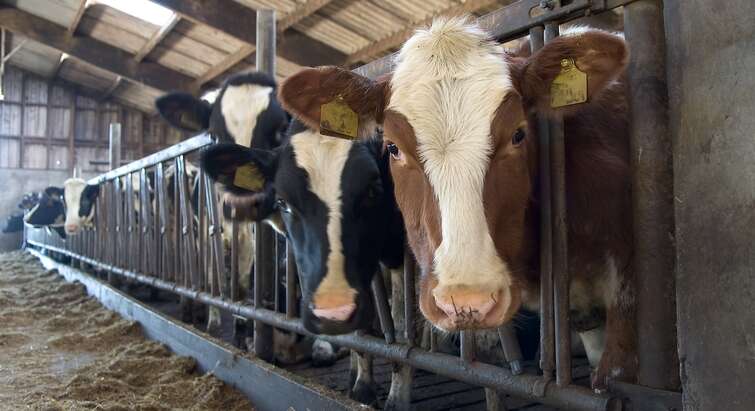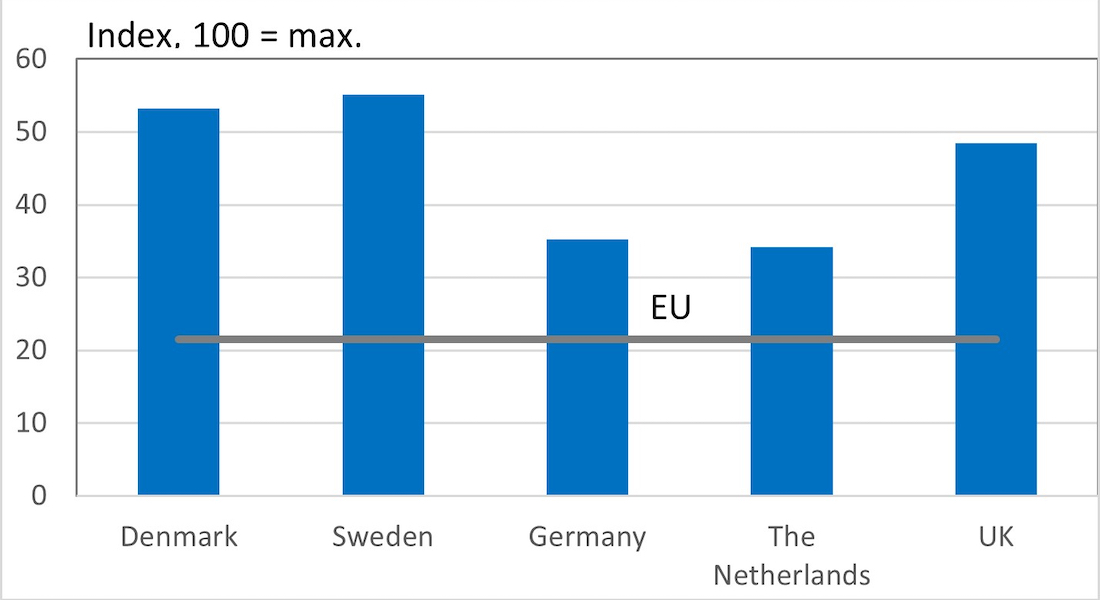
Benchmark for dairy cattle 2022

Most important messages from the figure
- A large cross-country difference can be seen regarding the requirements for dairy cattle welfare. Denmark is placed in the high end alongside Sweden. The United Kingdom of Great Britain and Northern Ireland (UK) is ranked almost as high, while the Netherlands and Germany are placed in the bottom close to the baseline.
- There are no joint EU requirements regulating the welfare of dairy cattle – apart from for the calves. Thus, the baseline indicated here, marked with a horisontal line, is (apart from the EU requirements laying down minimum standards for the production of calves) based on an estimate of the way dairy cattle will be kept and cared for, if focus is solely on the most efficient dairy production.
- Milk is used as a raw material for different kinds of food products, notably fermented milk products, butter, and cheese. So far, most market-driven initiatives have aimed at milk for drinking. However, it should be noted that only 10-15 % of milk production in our part of the world is used for drinking milk. Therefore, we have chosen not to make an estimate for dairy cattle consumption for now. Instead, we only look at national production.
Here you can read about the Benchmark method.
Further explanation of the results
The explanation for the high scores on the Benchmark scale for dairy production in Denmark and Sweden is twofold:
- Firstly, these two countries have more extensive welfare legislation for dairy cattle than the other three countries. Such legislation has existed in Sweden since 1988, including a requirement that all heifers and dairy cows must be put on pasture in the summer. In Denmark, there is no requirement about cattle being kept outdoors, but a law on dairy cattle was passed in 2010 including detailed requirements for housing and care of dairy cattle, e.g. regarding availability of special boxes for calving and for sick animals as well as a certain number of rotating cow brushes. The requirements in Danish legislation will be implemented by means of different transitional solutions. Some are already functioning, some will be valid from 2024, and the last ones will function from 2034.
- Secondly, in both countries in 2022, a relatively large part of dairy production was either organic or undertaken in accordance with another animal welfare label. In Sweden, 16 % of dairy production was organic, while in Denmark, 13 % of all dairy production was organic, and 10 % was produced to supply other animal welfare labels.
In the UK, a business standard called Red Tractor covers 95 % of production, which lifts the Benchmark value considerably compared to the baseline. Furthermore, in the UK in 2022, 3 % of dairy production was organic, and 9 % of production fell under other animal welfare labels.
The Netherlands and Germany are at the bottom in terms of Benchmark value for two reasons: Firstly, no national legislation makes demands that go further than the baseline. Secondly, hitherto, there has been a relatively low production of organic milk: 3 % of production in the Netherlands and 4 % of production in Germany. It is important to mention, however, that a further 62 % of milk production in the Netherlands and 31 % of milk production in Germany fall under other animal welfare labels which include requirements regarding putting heifers and dairy cows on pasture in the summer. In Denmark – besides the 13 % of milk production that was organic – only an additional 10 % of milk production was produced with summer pasture requirements in 2022. In 2022, Germany has implemented a four-step welfare label for dairy products called Haltungsform.
Animal welfare under pressure with anticipated effect in 2023
As a consequence of the coronavirus, the food crisis and the war in Ukraine and the resulting high prices on energy and food, the market-driven animal welfare has been under pressure from mid 2022. It takes time to readjust production. Therefore, it is anticipated that the effect of this will be seen in 2023, even though inflation and energy prices are once again stable. This anticipation can be substantiated by the following figure which shows the added cost in percentages given to Danish organic producers for delivered milk to dairies from 2018 to 2022:

The relatively unfavourable price development for organic milk production may have had a negative impact on organic milk production already in 2022, and a “lag” is to be expected in 2023, since we know that at the beginning of the year, Arla has chosen to reduce organic milk production by 100 litres per year, corresponding to around a fifth of the total organic milk production in Denmark. At the same time, the overall increasing retail prices have been a disadvantage for the more expensive dairy products, including organic dairy products.
Strengths and limitations
A paper based on the results regarding the dairy cattle Benchmark 2021 has been submitted and peer-reviewed, as is the case for the Benchmark studies for pig production and broiler production.
As with all other methods for making wider comparisons of animal welfare, the Benchmark method has several general limitations. The most important of these are described under the Benchmark method.
In particular, it must be mentioned that with the Benchmark method, researchers only look at demands for production which are based either on legislation or on different types of label or certification schemes. One may presume, however, that some farmers provide better care for the animals than what is required of them. This may be the case for quite many farmers, not least in the Netherlands and Germany. Therefore, in reality, dairy cattle welfare may be higher than what appears from the Benchmark values.
Conversely, we cannot know whether all farmers actually do what legislation and market-driven schemes require of them. This may mean that the actual animal welfare for dairy cattle may be lower in some places than what appears from the Benchmark target.
Dairy cattle production is much more complex than particularly broiler chicken production. Dairy cattle production consists of several steps, and there are more products: Besides milk for drinking and other dairy products, veal and beef are also produced. A limitation of the results presented here is that in terms of consumption, we only focus on production and consumption of milk for drinking, whereas production of beef and veal is not considered at all.
Recent publications: Benchmarking dairy cattle

